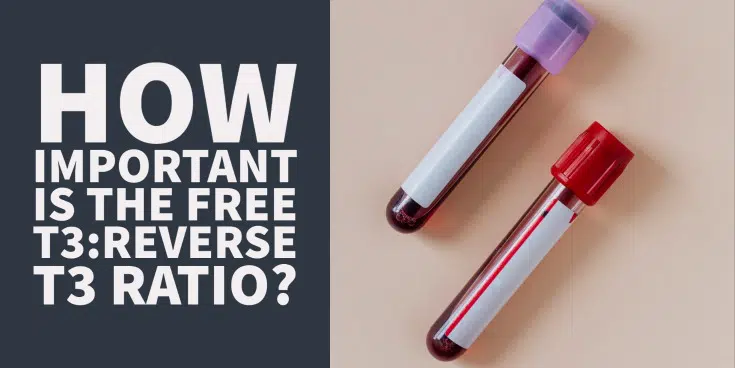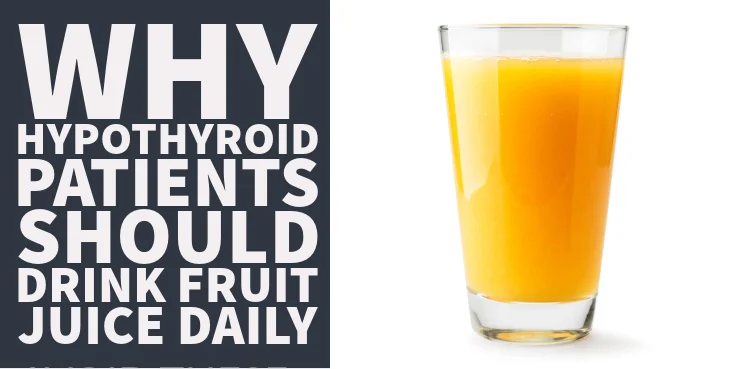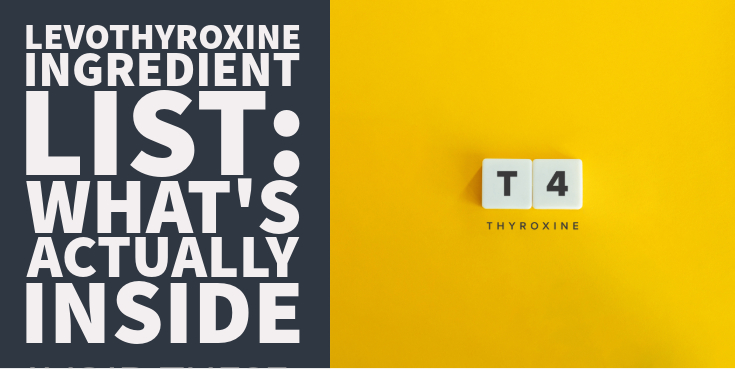As a thyroid patient, you’re probably well aware of some of the more advanced tests available to assess thyroid function including things like reverse T3 and sex hormone binding globulin.
But, are you aware of the calculation (not lab test) of the free T3:reverse T3 ratio?
This calculation can give you a lot of extended information about your thyroid and can/should be used by many of you.
This article will walk you through why it’s important, where it falls short, how to calculate it, and more.
DOWNLOAD FREE RESOURCES
Foods to Avoid if you Have Thyroid Problems:
I’ve found that these 10 foods cause the most problems for thyroid patients. Learn which foods you should avoid if you have thyroid disease of any type.
The Complete List of Thyroid Lab tests:
The list includes optimal ranges, normal ranges, and the complete list of tests you need to diagnose and manage thyroid disease correctly!
What is the Free T3:Reverse T3 Ratio?
If you are new to the thyroid world then these terms may not even make sense to you.
Don’t let that scare you away as they really aren’t that complicated to learn or to understand.
Let’s start with the basics:
What is the free T3:reverse T3 ratio?
This ratio is calculated when you divide these two values together.
What’s important for you to understand here is that this ratio is CALCULATED based on two other lab tests: the free T3 and reverse T3.
You need to know it’s a calculation because otherwise, you are going to be confused when you look at lab requisition forms and you don’t find it anywhere on there.
In order to get this ratio, you need to do a little bit of math.
But, don’t freak out because the math is easy and we will talk about the calculation a little bit more below.
But, before we do, here are just a few of the reasons you would want to do this math:
- This ratio helps you understand how well your body is converting T4 into T3 – read more about this here if you haven’t heard about this conversion process.
- It helps you understand if your current medication and dose are working for you – If your medication is working then your free T3 should be normal and your reverse T3 should be low/normal.
- It helps put your symptoms into context – Many people find that they are confused because of their so-called ‘normal’ lab tests and this ratio can explain how you can have a normal TSH but still not be getting enough.
- It can help you understand how to adjust your medications – many patients do well on a combination of both T4 and T3 medication but most doctors only prescribe T4. This can be a problem for certain individuals and you can identify if you fit into this category with the help of this ratio.
- It can help you understand other factors which you should be treating/evaluating – factors such as gut health and inflammation can all influence this ratio. If your ratio is off then it can help direct you to other problems which may be influencing your thyroid.
- It’s one of the most sensitive measures of thyroid function – the difference between your free T3 and your reverse T3 can identify thyroid dysfunction very early on and becomes abnormal long before other measures of thyroid function such as TSH and free T4.

What Does it Tell you?
Clinically speaking, this ratio is supposed to tell you how much free T3 you have RELATIVE to reverse T3 in your serum.
This is important because you can think about these two thyroid metabolites (T3 and reverse T3) as antagonistic to one another.
The more free T3 you have (within normal levels) the more likely your cells are to become activated by thyroid hormone.
The more reverse T3 you have in your body the more likely it is to BLOCK the positive effects of free T3 on your cells.
This occurs because both free T3 and reverse T3 compete for the same cellular thyroid receptors (1).
The main difference between them is that when free T3 is sitting on the thyroid receptor that good things are happening in the cell.
If reverse T3 sits on the receptor it does nothing for the cell except blocking the positive effects of T3.
So, as a patient, you want your free T3 levels to be much higher relative to your reverse T3 levels.
As long as you have sufficiently high free T3 levels you can make the assumption that your cells are being activated by thyroid hormone appropriately.
And your free T3:reverse T3 calculation simply tells you how likely this is to occur.
As a patient, you then have two things to worry about:
Factors that positively influence your free T3 level <– you do want this to happen.
And factors that increase your reverse T3 level <– you don’t want this to happen.
It turns out that there is a single mechanism that controls both levels at the same time.
This mechanism is referred to as T4 to T3 conversion or peripheral thyroid conversion.
This conversion process is incredibly important because it’s not under conscious control by you as the patient.
Instead, it’s under physiologic control based on the environment that your cells are in.
The more readily your body converts T4 into T3 the better.
There are several factors that influence this conversion process in a negative way including things such as calorie restriction (2) (this is why cutting your calories is so bad if you have thyroid disease!), chronic infections (3) (some of the same infections that trigger Hashimoto’s), inflammation (4) (from any cause), gut disruption (many thyroid patients suffer from GI issues), nutrient deficiencies (which is why I include certain nutrients in my thyroid conversion boosting supplement), and more.
These factors, if present in your body, will PUSH the conversion of T4 into reverse T3 instead of free T3.

The more severe the factors the more severe the disruption to thyroid conversion.
Early in my career, I use to see patients who were fresh off of the hCG diet come into my office and present with reverse T3 levels in the 40s to 50s ng/dL.
These levels are incredibly high with respect to the standard reference range which typically goes from around 5 to 25 ng/dL.
A reverse T3 level that high will almost always be accompanied by a very low free T3.
Why?
Because, in the case of calorie restriction, the body is trying to slow down the metabolism to match the reduced calories that you are consuming.
It does this by blocking thyroid hormone which would normally act to increase your metabolism, increase the number of calories that you burn, and increase your heart rate.
It blocks this process which slows down your metabolism, causes weight gain, lowers your heart rate, and lowers your body temperature.
Calculating your Free T3: Reverse T3 Ratio
Remember when I said you would have to do some math to get this value? Well, we are on that part.
Don’t freak out though because it’s very easy to calculate.
All you need to do is take your free T3 and divide it by your reverse T3 (see the example below).
The only somewhat challenging part can be ensuring that your units are correct.
This is typically only an issue if you are getting your lab test outside of the United States but for the purposes of this article you need to make sure that your units are as follows:
- Free T3 (sometimes referred to as triiodothyronine, free on lab tests) should be in pg/mL
- Reverse T3 (sometimes referred to as triiodothyronine, reverse on your lab tests) should be in ng/dL
If your reverse T3 and free T3 are not in the proper units you can use a calculator such as this one to transfer them to the correct units.
Once your units are correct then you can simply do the calculation.
So, what kind of value should you be looking for?
In general, you want your calculated value to be greater than 0.20.
If your calculated value is less than 0.20, such as 0.15 or something similar, then this might be an indication that you have an issue with thyroid conversion or you are on the wrong medication.
From here you may want to favor therapies that tend to increase your T3 (such as those found here) over therapies that tend to increase your T4.
Let’s look at a practical example (from one of my patients):


In this example, we have our value of 2.8 for our reverse T3 and a value of 14.4 for our free T3.
Because they are in the proper units (free T3 is in pg/mL and reverse T3 is in ng/dL) we can divide 2.8 by 14.4 to get the value of 0.194.
This value is less than our 0.20 cutoff that I mentioned previously and so this patient may have an issue that needs to be corrected.
In this situation, I would take a deep dive into the history and other lab tests of this patient to determine if they are indeed converting thyroid appropriately or if they have issues that may be blunting this process from occurring.
If the units are not correct then you would want to convert them before doing the calculation.
Remember, though, that this calculation is not perfect and the ratio that works for your body may be different from what others need.
So don’t be alarmed if you find that your free T3:reverse T3 ratio is less than 0.2 and you are feeling amazing.
If you are feeling poorly, however, then this data point can definitely help put you on a different path and help you.
How helpful is it?
The question really becomes:
How helpful is calculating the free T3:reverse T3 ratio and is it something that you should look at every time you order your lab tests?
The answer is not as straightforward as you might think.
While calculating this ratio is certainly helpful, I wouldn’t consider it vital in every single case.
Certainly, however, if you looked at the data you would find that some consider this ratio to be the single most important thyroid test (or calculation, depending on how you look at it).
But I just don’t see this to be true in clinical practice.
One reason for this is that this ratio can be manipulated based on the type of thyroid medication that you are taking and the time of day that you get your lab tests drawn.
This can result in you forcing your ratio into an “optimal” range and yet still feeling the symptoms of hypothyroidism.
The reason for this has to do with how volatile your serum free T3 level can be.
For instance, if you take any medication which contains T3 and then check your thyroid lab tests within a few hours, you will find that your free T3 level skyrockets up.
It will rocket up to high levels but it will eventually fall down over the next 24 hours.
So, depending on when you test your free T3, and when that compares to when you took your T3 medication, you can artificially adjust your free T3:reverse T3.
But this doesn’t necessarily mean that you are doing the right thing or even helping your situation.
So, what does this mean for you as the patient?
It means that the free T3:reverse T3 ratio is something that you will want to keep an eye on it, but I wouldn’t base or adjust your medication solely on this factor.
When you get into advanced thyroid lab testing you can also check other factors such as your sex hormone binding globulin and total T3.
Both of these lab tests tend to be better markers of long-term T3 status in the body.
Your Doctor and the Free T3:Reverse T3 Ratio
Based on how important of a calculation this ratio is, you might be surprised to find out that your doctor may have never heard about it.
If it’s so important why don’t more doctors know about it?
I think the main reason has to do with the fact that most doctors are content looking at the TSH and Free T4 values.
From their perspective, there really isn’t any other reason to look beyond those tests because that is how they are trained.
But that doesn’t make this ratio any less important, especially for those who have more atypical types of cases.
In fact, the more atypical case that you have, the more likely you are to benefit from extended thyroid lab tests and calculations.
And by atypical I am referring to those patients who don’t respond well to T4 medications such as Synthroid or levothyroxine, to those patients who are taking medication but are still symptomatic, and so on.
These types of patients benefit greatly from calculating this ratio.
The good news is that you don’t really need your doctor to calculate this test but you do need him/her to order the requisite lab tests on your behalf.
Once you have the lab tests though you can simply use the guidelines above to calculate it.
As always, my recommendation is to find a doctor who is willing to work with you but if that isn’t possible given your circumstances then you can still go about calculating it yourself.
Conclusion
My personal opinion is that you should not only be aware of the free T3:reverse T3 ratio but that you should also understand how to calculate it and at least calculate it on some of your lab tests.
Believe it or not, however, I don’t actually calculate this ratio myself on all of the patients that I treat.
This is not because I don’t think it’s important but more because I can generally see the trend of the free T3 and reverse T3 and overall thyroid pattern without doing the actual calculation.
But, understanding the importance of this metric is very important, especially for those who are just starting on their thyroid journey.
Now I want to hear from you:
Have you calculated your free T3:reverse T3 ratio?
What did your results tell you?
Was it what you were expecting?
What do you think could be contributing to your result?
Leave your questions or comments below!








